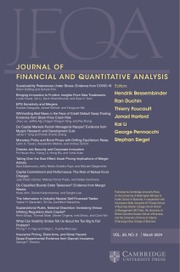Article contents
Return Extrapolation and Volatility Expectations
Published online by Cambridge University Press: 28 March 2025
Abstract
This article provides the first comprehensive evidence that the return extrapolation behavior of investors leads to biases in the expectations of volatility. Lower past returns are associated with higher expectations of volatility when using the physical, risk-neutral, and survey measures to estimate volatility expectations. Consistent with the return extrapolation framework, recent past returns have a larger impact than distant past returns on volatility expectations. Biases in volatility expectations are i) distinct from extrapolating past realized volatility, ii) asymmetrically induced by recent past negative returns, and iii) lead investors to pay more to insure against the perceived higher expected volatility.
Information
- Type
- Research Article
- Information
- Creative Commons
- This is an Open Access article, distributed under the terms of the Creative Commons Attribution licence (http://creativecommons.org/licenses/by/4.0), which permits unrestricted re-use, distribution and reproduction, provided the original article is properly cited.
- Copyright
- © The Author(s), 2025. Published by Cambridge University Press on behalf of the Michael G. Foster School of Business, University of Washington
Footnotes
We thank Thierry Foucault (the editor) and an anonymous referee. We also thank Adem Atmaz, Hui Chen, and seminar participants at the 2022 FIRN conference, Monash University, University of Technology of Sydney, University of Adelaide, Deakin University, La Trobe University, and University of Otago for helpful comments. All remaining errors are our own.
References
- 1
- Cited by

